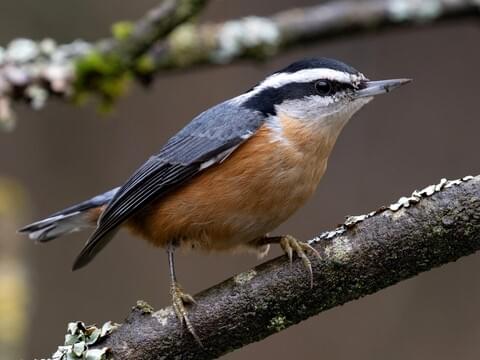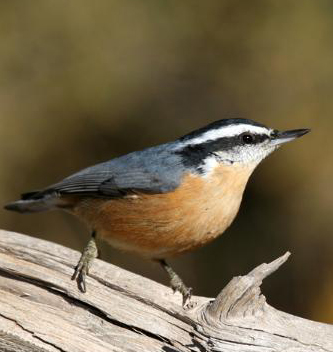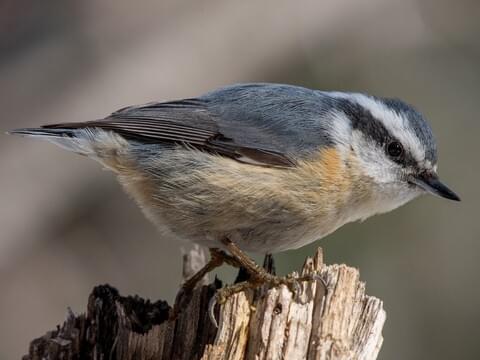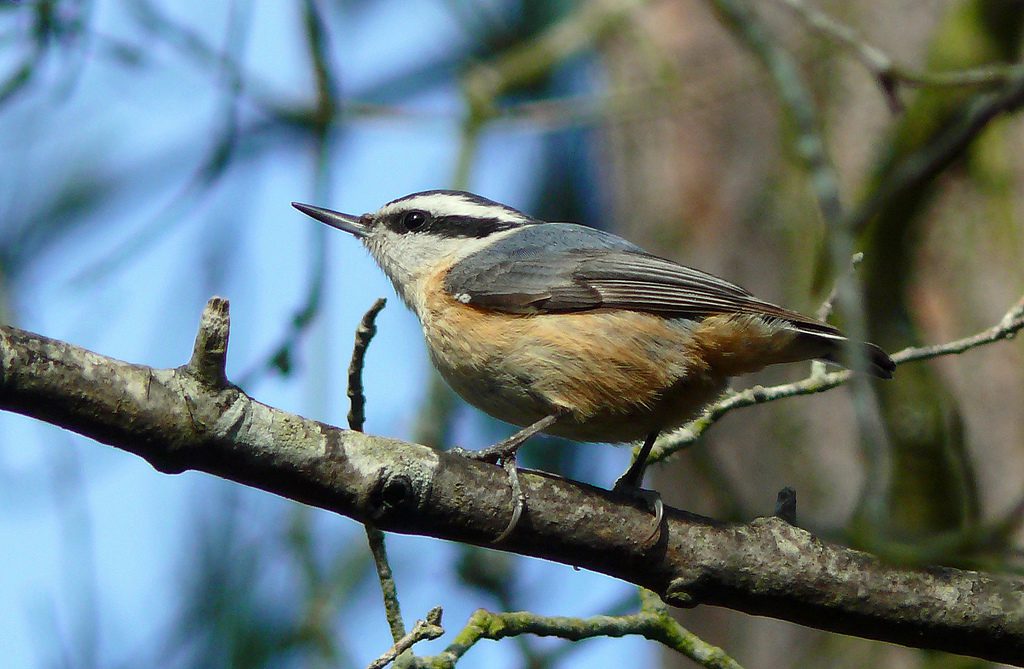Red-breasted Nuthatches are delightful little songbirds that can be found in the forested areas of the United States. With their blue-gray upper parts, rusty-red under parts, white faces, and black caps, they are a pleasure to behold. Measuring about 4-1/2 inches long, these small birds have a wingspan of 8-1/2 inches. Red-breasted Nuthatches primarily feed on insects and spiders during the summer, and on the seeds of pine cones during the autumn and winter. They have unique foraging behavior, crawling head-first down tree trunks and using short, jerky hops. These birds are monogamous and expert nest builders, laying 5-7 cream-colored eggs with brown spots. With their fascinating behaviors and stunning appearance, Red-breasted Nuthatches are truly a remarkable addition to any backyard or forested area.
Habitat and Range
Red-breasted Nuthatches, small songbirds known for their distinctive appearance and behavior, are primarily found in the forested areas of the United States. These birds are specifically drawn to habitats with an abundance of coniferous trees. Forests provide them with ample food sources, shelter, and suitable nesting sites. The distribution of Red-breasted Nuthatches is widespread across the United States, with populations present in both the eastern and western regions of the country.
Physical Characteristics
Measuring about 4-1/2 inches in length, Red-breasted Nuthatches are considered relatively small in size. Their wingspan reaches approximately 8-1/2 inches, allowing them to maneuver gracefully through their forest homes. These birds exhibit striking coloration and markings. Their upper parts are blue-gray in color, creating a beautiful contrast against their rusty-red underparts. A distinguishing feature of Red-breasted Nuthatches is the white face and black cap that extends to the back of their heads, adding to their unique appearance.

Diet and Feeding Habits
Red-breasted Nuthatches have specific dietary preferences that vary throughout the year. During the summer months, these birds primarily rely on insects and spiders as their main source of food. They use their sharp bills to extract these small creatures from the nooks and crannies of tree bark. In the autumn and winter, Red-breasted Nuthatches shift their feeding habits to include the seeds found in pine cones. Their strong bills allow them to easily crack open the cones and extract the seeds. The ability to adapt their diet to the changing seasons ensures their survival and sustenance.
Foraging Behavior Red-breasted Nuthatches exhibit interesting foraging behavior that sets them apart from other bird species. They are known for their unusual habit of crawling head-first down tree trunks, utilizing their strong claws and stiff tail feathers to maintain balance and grip onto the bark. This behavior allows them to explore tree crevices and extract hidden insects or seeds. Additionally, they employ short, jerky hops to move between branches and trees, searching for food.
Migration and Seasonal Patterns
Residency in Conifer Forests Red-breasted Nuthatches are resident birds in various conifer forests. They typically maintain a permanent presence in these forests throughout the year. This residency ensures a consistent availability of food sources and suitable nesting sites.
Southward Migration in Irregular Winters During irregular winters when food may become scarce in certain areas, Red-breasted Nuthatches exhibit a southward migration. Large numbers of these birds may travel to more favorable habitats to find abundant food sources and ensure their survival. This migratory behavior allows them to adapt to changing environmental conditions and secure their long-term well-being.

Breeding and Reproduction
Monogamous Behavior Red-breasted Nuthatches exhibit monogamous behavior, forming pair-bonds that typically last for one breeding season. Males actively court females through various displays and vocalizations, showcasing their suitability as mates. Once a pair bond is established, both male and female work together to raise their offspring.
Nesting Habits Red-breasted Nuthatches prefer to excavate their own nest cavities, typically in decaying or dead trees. They use their strong beaks to create holes in the wood that serve as their nesting sites. These cavities offer protection from predators and inclement weather. The male and female work together to excavate the nest, with the female taking the lead in the construction process.
Egg Characteristics After the nest is completed, the female lays a clutch of 5-7 eggs. These eggs are creamy in color with brown spots, providing camouflage and protection from potential predators. The female diligently incubates the eggs while the male supports her by providing food and protecting the nest.
Parental Care Once the eggs hatch, both parents actively participate in caring for the nestlings. They take turns feeding the hungry chicks, ensuring they receive a nutritious diet for optimal growth and development. As the nestlings mature, the parents gradually introduce them to the outside world, teaching them essential skills such as foraging and flying. This teamwork between the parents ensures the successful upbringing of their offspring.
Social Behavior and Communication
Unique Foraging Behavior Red-breasted Nuthatches exhibit unique foraging behavior that is characteristic of their species. Their ability to crawl head-first down tree trunks sets them apart from many other birds. This behavior enables them to access hidden insect prey in hard-to-reach crevices, giving them an advantage in finding food sources. Their agility and dexterity while foraging make them fascinating to observe in their natural habitats.
Food Caching In preparation for the winter season when food becomes scarce, Red-breasted Nuthatches engage in the behavior of food caching. They store excess seeds in crevices and bark of trees, creating a “pantry” of food reserves. By caching food, they ensure a steady supply of sustenance during challenging times when food availability is limited. Their excellent memory helps them remember the locations of these hidden food caches.
Mixed-Species Foraging Flocks During the winter season, Red-breasted Nuthatches often join mixed-species foraging flocks. These flocks consist of multiple bird species that come together to search for food collectively. By joining forces, the birds increase their chances of finding food and provide each other with enhanced protection against predators. This social behavior demonstrates the cooperative nature of these birds and their ability to adapt to changing circumstances.

Lifespan and Predators
Average Lifespan The average lifespan of Red-breasted Nuthatches is approximately 6 years. However, some individuals have been known to live for up to 10 years. Factors such as predation, disease, and environmental conditions can impact the longevity of these birds.
Predators and Threats Like many other bird species, Red-breasted Nuthatches face several predators and threats in their natural habitats. Predatory birds such as hawks and owls pose a significant risk to their survival. Additionally, mammals such as snakes, raccoons, and squirrels may prey upon their eggs or nestlings. Habitat loss due to human activities, climate change, and the use of pesticides also contribute to the endangerment of these birds.
Conservation Status
Population Trends While specific population data for Red-breasted Nuthatches are not readily available, they are not currently listed as a species of concern. However, ongoing monitoring and conservation efforts are essential to ensure their long-term viability and the preservation of their habitats. Continued protection and restoration of conifer forests are crucial for maintaining healthy populations of these birds.
Conservation Efforts Conservation efforts to protect Red-breasted Nuthatches and their habitats involve the establishment of protected areas, such as national parks and reserves. These areas provide a safe haven for these birds to thrive and nest. Additionally, planting native trees and creating suitable habitats in urban and suburban environments can help support populations of Red-breasted Nuthatches and other bird species.

Interesting Facts
Use of Pine Pitch Red-breasted Nuthatches are known for their unique use of pine pitch. They collect sticky sap from pine trees and apply it around the entrance of their nesting cavities. This pitch acts as a deterrent for potential predators, making it difficult for them to access the nest. This resourceful behavior showcases the adaptability and intelligence of these birds.
Use of Old Nest Cavities In addition to excavating their own nest cavities, Red-breasted Nuthatches also utilize old nest cavities created by woodpeckers or other birds. They make adaptations to these existing holes, modifying them to suit their needs. This behavior demonstrates their resourcefulness and ability to take advantage of available nesting opportunities.
Attracting Red-breasted Nuthatches to Your Backyard
Food To attract Red-breasted Nuthatches to your backyard, provide them with appropriate food sources. Offer a variety of bird feeders filled with seeds and suet specifically designed for small songbirds. Red-breasted Nuthatches particularly enjoy sunflower seeds, peanuts, and suet cakes. Ensure the feeders are regularly cleaned and stocked to maintain the birds’ interest.
Trees and Vegetation Planting coniferous trees such as pines, spruces, and firs in your backyard can create an attractive habitat for Red-breasted Nuthatches. These trees provide not only food sources but also shelter and nesting sites. Incorporate native plants and shrubs that attract insects, as they are an essential part of the birds’ diet.
Water Maintaining a clean and accessible water source, such as a birdbath or shallow basin, can entice Red-breasted Nuthatches to visit your backyard. Providing fresh water for drinking and bathing is crucial for their survival. Ensure the water is changed regularly to prevent stagnation and the spread of diseases.
Nest Boxes Consider installing nest boxes in your backyard to provide Red-breasted Nuthatches with suitable nesting sites. These boxes should mimic the natural cavities found in trees. Ensure the boxes are securely mounted and positioned away from potential predators. Monitor the boxes throughout the breeding season to ensure successful nesting and fledging of the young birds.
By offering appropriate food, trees, water, and nest boxes, you can create an inviting environment that attracts and supports Red-breasted Nuthatches in your backyard. Enjoy the beauty and charm of these small songbirds as they entertain you with their delightful behaviors and unique calls.

Leave a Reply